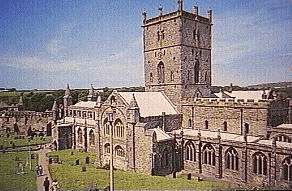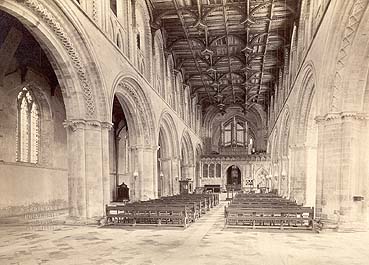
David or Dewi Sant is the patron saint of Wales. On March 1 every year Welsh children celebrate
St David's day with the girls wearing national costume. Leeks and daffodils abound. In Pembrokshire,
St David's Cathedral stands in a magical location where David is supposed to have lived his 6th Century
Celtic monk's life.

David was probably one of the (if not the) most influential of the early Christians in Wales
during the '.' The cathedral built in his name in the 12th Century was a highly significant shrine
for medieval Christians - two pilgrimages to St. Davids equaled one to Rome. But who was David?
According to the biography of David written by Rhigyfarch (c. 1095) he had almost
magical powers:
"Saint David "then enters the synod; the company of bishops is glad, the
multitude is joyful, the whole assembly exults. He is asked to preach, and does not decline
the synod's decision. They bid him ascend the mount piled up with garments; and in the sight of all,
a snow white dove from heaven settled on his shoulder, and remained there as long as he
preached. Whilst he preached, with a loud voice, heard equally by those who were nearest and
those who were furthest, the ground beneath him grew higher, rising to a hill; and'staioned on its summit,
visible to all as though standing on a lofty mountain, he raised his voice until it rang
like a trumpet ..."
Afterwards, blessed and extolled by all, he is constituted archbishop of
the entire British race, by the unanimous consent of the bishops, kings, princes, nobles, and those of every
rank; his city is also declared the metropolis of the whole country, so that whosoever
ruled it should be regarded as archbishop."
Glanmor Williams (1974:1) demolishes this myth by saying that: "We cannot, unfortunately, believe most of the details as the saint's
biographer recorded them. They come from a biography which was not written until five
hundred years after the saint was dead. (the) ... work is, like most medieval saints' lives,
an amalgam in which legend heavily overlies facts."
Williams (1974: 2) goes on to observe that facts about David "are
perilously slender and can be quickly summarized. We have no certain knowledge of the
dates of his birth or death; but there is no doubt that he flourished in the sixth century
and he may have died in the year 589. He was one of those illustrious monk-missionaries
of the Celtic Age of Saints."
 Photograph from the Russell Sturgis Collection, Washington University Archives, St. Louis Missouri.
Photograph from the Russell Sturgis Collection, Washington University Archives, St. Louis Missouri.
Breton evidence
One of the few Celtic Saints' Lives that can be precisely dated is that of
St Paul of St Pol-de-Lion, near Roskoff in Brittany. The author was one Wrmonoc, a
monk in the abbey of Lendevennec, also in Brittany. This Life was written in
884, three hundred years earlier than many of the traditions preserved in Welsh
manuscripts. According to Wrmonoc: "The same St Paul, surnamed Aurelian, the son of a certain count named Perphirius, who
held a position of high rank in the world, came from a province which in the language of
the British race is called Penn Ohen."
Later, Wrmonoc says that Paul was sent to Illtud's monastic school at Lan-Iltut
(Llantwit Major, Glamorgan in Wales). There:
"Iltut had many young men distinguished for piety and learning among his disciples, but four of them
far outshone the others and by the command of the master were placed in a position of
authority over them. These were: first, Saint Paul, of whose life and mighty works in the
northern part of the country of Domnonia this book deals; Saint Dewi (Devius) ... also Samson, the
holy bishop ... and lastly Saint Gildas."
Williams (1974: 3) observes that this account includes the first known reference
to David as "Aquaticus" or "Waterman" - an acknowledgement of the extreme asceticism with
which he was associated.
Dewi (David) was one element of an extensive collection of
Doble, in his Lives of the Welsh Saints goes into the roots of Wrmonoc's tales and
argues that the Breton monk had confused at least three early clerics called Paul or Paulinus.
An Irish connection?
According to Williams (1974: 3), David was mentioned in two early Irish sources:
"... the Martyrology of Oengus the Culdee, dating from c.800, where the date of
his feast is given as 1 March; and the Catalogue of Irish Saints, now thought to date from
the ninth or the tenth century."
Dr Moran, Bishop of Ossory, in his Irish Saints, identifies
the Welsh Saint David with an Irish Druid. According to Moran, David's mother
was an Irish Christian. David sailed across to Menevia (Pembrokeshire) and
lit a fire on the shore, its smoke filling the land. Then, says Moran:
"The owner of the district was an Irishman, named Baya, a pagan and a Druid.
He was one of those successful rovers who years before had carved out
territories for themselves on the Welsh coast, and continued to hold them
by the sword. He was filled with horror when he saw the smoke that arose from
St David's fire, and cried out to those that were with him, 'The enemy
that has lit that fire shall possess this territory as far as the smoke
has spread.' They resolved to slay the intruders, but their attempt was
frustrated by a miracle. Seeing this, Baya made a grant of the desired
site, and of the surrounding country to St David, whose monastery quickly arose."
Evidence of the Irish presence in post-Roman Wales comes in the form
of inscriptions.



